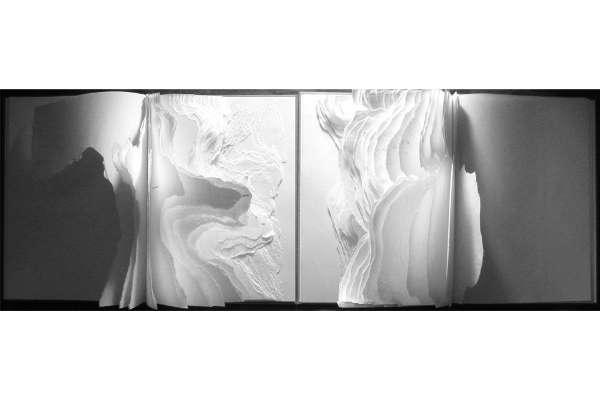Ineinandergeschachtelt
Book-Object-Score. 2 books, each 21.5 cm x 30 cm. Varying versions, limited edition of five pieces (2007-2015).
Both books serve as a score and vocal instruction for respectively 62 ways of saying the word „ineinandergeschachtelt.“ The first 57 entries originate from the chapter entitled „Boxes“ from „The Five Senses“ by Michel Serres; as is the score’s lead-in quote, out of which the word „ineinandergeschachtelt“ is taken.


Photos © Angela Ankner
Holger Schulze
Felt and folded
ineinandergeschachtelt
by Christoph Illing
Contribution to Notation 21
American Musicological Society
2007
Again and again I open the pages of this delicate book. As I
open it the softness of the fringy margins strikes me. The
pages are ripped in a thoughtful, delicate way, thus as I flick
through..., no: as I unfold this book I sense velvet in these
fluffy margins. Thin hand-made paper and a dense
typography, called Microgram.
There are editions of this partitura, all hand-crafted by its
Berlin-based and techno-experienced composer Christoph
Illing, that bear a tender drawing on all the pages. The same
drawing of an androgynous, young human being, naked and
cuddled up before me − his or her shy observer. But not all
editions show this drawing. Flickering through the pages
those cracks bear – eventually, eventually not − ever and
ever new insights and throughsights on this drawing: Never
do I see the whole picture of him or her, so keenly desired
according to pornographically inclined aesthetics of
dominating broadcasting corporate media. Eventually do I
see nothing more than the bare fine, hand-made paper. Void.
This book is called ineinandergeschachtelt (meaning
approximately: nested, boxes in boxes) and it shows on each
page another word. Rau, leise, voll, flehend, vulgär, schrill,
zornig, jovial, wohlklingend, gebieterisch, markerschütternd,
verführerisch, explosiv: hoarse, low, full, pleading, vulgar, sharp,
angry, jovial, melodious, commanding, heartrending, seductive,
explosive. Consecutively numbered from 1 to 62, these words
are taken from a paragraph of Michel Serres' famous (yet still
rarely acknowledged) plea for a renewed anthropology of the
senses, Les Cinq Sens (1985). These words cue my
imagination, my vocal sensorium, my imagination about how
my voice could sound: egalitär oder komplizenhaft, arrogant,
ermutigend, destruktiv, oder liebkosend, ironisch, aggressiv,
zynisch − egalitarian, or matey, impertinent, encouraging,
destructive or tender, ironic, aggressive, cynical. How would I
feel my voice? How could I sense myself speaking?
The partitura starts with the general vocal instruction
»(Sprich nach jedem nummerierten Papier:
ineinandergschachtelt)« »(After every numbered paper
speak: ineinandergeschachtelt« . Performers of this piece are
expected to speak or sing or articulate or simply perform the
German title of the piece, »ineinandergeschachtelt« 62 times
(respectively 124 times when performing both
complementary partituras of book I and II: the second
consisting of the torn out halves of all pages).
After the first 57 instructions, taken directly from Serres, the
pages change, the book and partitura transform. The pages
are no longer torn. The fringy, velvet, folding and unfolding
look and feeling disappears abruptly. The pages are now
integral again. And if they showed one before, they bear no
drawing anymore now. Simply words. Firstly: »Felt Sense«.
And then: »(Richte Deine Aufmerksamkeit auf Deine
Körpermitte und darauf wie sich Dein Inneres anfühlt...)« −
»(Point your concentration to the center of your body and
sense how your inside feels right now...)«
The performer is left with him- or herself. And the last five
vocal instructions present phrases that leave space for the
interpretation of the performer: to state how she or he feels
and senses the words, the drawing, the paper, his/her own
situation right now − or even something else. »58. Alle diese
ausgesprochenen Worte sind ..... 59. Die Zeichnung ist .....
60. All dies Papier ist ..... 61. Meine Situation ist ..... 62. .....
« − »58. All of these spoken words are ..... 59. The drawing
is ..... 60. All this paper is ..... 61. My situation is ..... 62.
.....«
The performer is drawn back to her- or his felt sense of the
actual situation and its effects on him or her. The term Felt
Sense, Illing refers to, is central to the philosophy and
phenomenology of language, developped by US-american
thinker Eugene T. Gendlin. Gendlin, who is also the father of
the Focusing-therapy, worked on this theory since the 1960s.
At the core of his writings and practices lies the realization –
in a field between Wittgenstein and Husserl – that there is a
bodily sense of meaning, a proprioreceptive cognition that
bears the ground for any individual making use of words and
speech acts. According to Gendlin language does not end
when we are grasping for words as dominant theories of
language typically say. Speaking begins right there and then,
when we do not rely on patterns any longer, on clichés and
routines: When we give ourselves the space and time of
letting newly, bodily grounded constellations emerge, a felt
sense out of feelings, sensations, sounds, smells, images,
metaphors, phrases, words that come up. Meaning emerges
out of proprioreceptive cognition. Meaning thus is bodily
anchored.
In the work of Gendlin this openness to new generations of
meaning is often represented by ".....". And so it is in Illing's
work here. The performance of ineinandergeschachtelt can
thus not be reduced to a manifestation of vocal instructions.
Performing ineinandergeschachtelt means to take the book, the
drawing eventually, the cracks, the paper, the words, the
instructions as groundwork out of which a felt sense of
ourselves might emerge. My body, as a performer, becomes
the stage. Ineinandergeschachtelt happens in my felt sense.
As the singer Ulrike Sowodniok, performer of the world
premiere, says:
»The structure of the material itself − the torn paper − moves
into the foreground and shows a multitude of perspectives.
The body reflects and reacts to the quality of the given
words. The voice is not used for deliberate interpretation of
affection − in this case it shows through its own structure
through the behaviour of the larynx itself the quality and the
meaning of the given words. Interpretation becomes
reflection.«
Felt anf folded was written by Holger Schulze at June 11th 2007.
Many thanks to him!
Felt anf folded was first published in:
2009 Theresa Sauer (ed.): Notations 21, Mark Batty Publisher New York, S. 111f.



